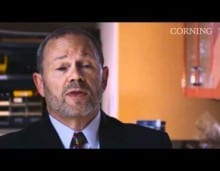Vish Nandlall’s 2015 Technology Trends – Telstra
Telstra’s Chief Technology Officer Vish Nandlall shares his top five technology predictions for 2015.
Transcript:
(DYNAMIC ELECTRONIC MUSIC)
Hi, my name is Vish Nandlall
and I’m the CTO for Telstra.
Today, I’m going to
talk to you about
my 2015 technology predictions.
And they’re all based on
a new abstraction that I see
that’s really gonna be
the foundation
for every application
that’s delivered.
It’s about a mobile connected
world of things
stretched through a reasoning engine
based on big data,
with the destination
being the cloud.
So trend number one
is about machine vision.
Imagine taking out your smartphone
and being able to capture
an image of a bottle of wine
that you’re taking to your
potluck supper over Christmas
and having all the information
basically triggered
through a visual search.
It turns out
that that’s 30% more precise
than using a text-based search.
Machine vision is starting to come
out of the technology backwaters
into your smartphone.
As we move into 2015,
smartphone machine vision
is going to be better at
identifying images than humans will.
Trend number two is that voice
is gonna be sexy again.
As a CTO, you like to think about
“What are the things in the world
that I believe that no-one else
believes?”
And while voice has been in decline
from a business perspective,
people are still talking a lot.
And it turns out that voice
is the perfect way to interact
with our connected home.
Imagine asking your umbrella
whether you should take it out
because it may rain that day.
And the umbrella responding,
“Of course you should take me out.
It’s gonna rain today.”
That, I think, is one of the more
compelling new technologies
that are coming to the forefront
in 2015.
Trend number three is about clouds.
Today, clouds act very much
as islands of applications
that are being delivered
to consumers.
What we want are the clouds
to start talking to one another.
Applications are becoming really,
really sophisticated.
If you’re running
a gaming application
and you’re fragging
your next-door neighbour,
that may go through
multiple different clouds.
And so the real-time perception
that the user gets
is a bit of a lag time if it has to
move between one cloud to the next,
and talk through
different languages.
What we want is that to happen
seamlessly.
And so in 2015 we’re seeing a lot
more technology advances in terms of
“How do I dynamically set up
those links between the cloud?”
“How do I create
an interoperable language
“so that clouds can talk
to one another seamlessly?”
Trend number four
is all about the data of things.
So imagine today
that the data is locked in
these specific applications.
What you want is that data
to be federated,
or put into one big platform
where it can be extracted and used
to create new meaningful
conveniences for consumers.
So, the best example of that is
something called Propeller Health.
Well, Propeller Health has
a connected inhaler, of all things.
That connected inhaler is using data
that comes from your Fitbit
to find out your health context.
It’s using data
from the weather network
to find out what the conditions
are outside,
whether there’s a lot of allergens
in the air or pollutants in the air.
And all of this information
comes together
to deliver to the consumer
whether or not their asthma problem
is gonna be elevated today
or whether it’s gonna be
a little bit more benign.
These are really important things
in terms of managing health
moving forward.
And by federating that data
and unlocking it
from these applications,
we’re gonna find new benefits
that we can serve consumers with.
OK, so trend number five
is really about security.
So imagine a world
in the internet of things
where there’s 50 billion end points.
The problem isn’t the
confidentiality of the information
coming out of those end points,
it’s about locking down
those end points.
You can have all the confidentiality
you want in the world,
you can have an armoured truck
driving around the things
in your house,
but if someone can come through your
front door, it really isn’t secure.
Data integrity
allows you to own your data.
It allows you to put
a net around it,
pull it back
when you don’t want it exposed,
and to give permissions to use it
when you do want it exposed.
This is gonna set a new agenda
for security and privacy
moving into 2015.
OK, so those are my top five
predictions for 2015.
I was really excited
to share them with you today.
Please let me know what you think
and whether you think
I’ve left things out
or how you think
these technology trends
are gonna impact your lives in 2015.
So thank you very much
and I’ll see you next time.
source
